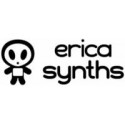





|
A synthesizer (also spelled synthesiser) is an electronic musical instrument that generates audio signals. Synthesizers generate audio through methods including subtractive synthesis, additive synthesis, and frequency modulation synthesis. These sounds may be shaped and modulated by components such as filters, envelopes, and low-frequency oscillators. Synthesizers are typically played with keyboards or controlled by sequencers, software, or other instruments, often via MIDI. Synthesizer-like instruments emerged in the United States in the mid-20th century with instruments such as the RCA Mark II, which was controlled with punch cards and composed of hundreds of vacuum tubes. The Moog synthesizer, developed by Robert Moog and first sold in 1964, is credited for pioneering analog synthesis concepts such as voltage-controlled oscillators, envelopes, noise generators, filters, and sequencers. In 1970, the cheaper, smaller Minimoog standardized synthesizers as self-contained instruments with built-in keyboards, compared to the modular synthesizers before it. The first mass-produced synthesizer, the Yamaha DX7, was launched in 1983, popularizing digital synthesis. Software synthesizers now can be embedded on single microchips in any electronic device. Synthesizers were initially viewed as avant-garde, valued by the 1960s psychedelic and counter-cultural scenes but with little perceived commercial potential. Switched-On Bach (1968), a bestselling album of Bach compositions arranged for synthesizer by Wendy Carlos, took synthesizers to the mainstream. They were adopted by electronic acts and pop and rock groups in the 1960s and 1970s, and widely used in 1980s rock. Sampling, introduced with the Fairlight synthesizer in 1979, has influenced all genres of music and had a major influence on the development of electronic and hip hop music. Today, the synthesizer is used in nearly every genre of music, and is considered one of the most important instruments in the music industry. According to Fact in 2016, "The synthesizer is as important, and as ubiquitous, in modern music today as the human voice |